- News
- Reviews
- Bikes
- Components
- Bar tape & grips
- Bottom brackets
- Brake & gear cables
- Brake & STI levers
- Brake pads & spares
- Brakes
- Cassettes & freewheels
- Chains
- Chainsets & chainrings
- Derailleurs - front
- Derailleurs - rear
- Forks
- Gear levers & shifters
- Groupsets
- Handlebars & extensions
- Headsets
- Hubs
- Inner tubes
- Pedals
- Quick releases & skewers
- Saddles
- Seatposts
- Stems
- Wheels
- Tyres
- Tubeless valves
- Accessories
- Accessories - misc
- Computer mounts
- Bags
- Bar ends
- Bike bags & cases
- Bottle cages
- Bottles
- Cameras
- Car racks
- Child seats
- Computers
- Glasses
- GPS units
- Helmets
- Lights - front
- Lights - rear
- Lights - sets
- Locks
- Mirrors
- Mudguards
- Racks
- Pumps & CO2 inflators
- Puncture kits
- Reflectives
- Smart watches
- Stands and racks
- Trailers
- Clothing
- Health, fitness and nutrition
- Tools and workshop
- Miscellaneous
- Buyers Guides
- Features
- Forum
- Recommends
- Podcast
review
£6,725.00
VERDICT:
Lightweight, very fast and comfortable - a super-high performance bike that won't disappoint, if you have the cash
Weight:
6,780g
Contact:
www.trekbikes.com
At road.cc every product is thoroughly tested for as long as it takes to get a proper insight into how well it works. Our reviewers are experienced cyclists that we trust to be objective. While we strive to ensure that opinions expressed are backed up by facts, reviews are by their nature an informed opinion, not a definitive verdict. We don't intentionally try to break anything (except locks) but we do try to look for weak points in any design. The overall score is not just an average of the other scores: it reflects both a product's function and value – with value determined by how a product compares with items of similar spec, quality, and price.
What the road.cc scores meanGood scores are more common than bad, because fortunately good products are more common than bad.
- Exceptional
- Excellent
- Very Good
- Good
- Quite good
- Average
- Not so good
- Poor
- Bad
- Appalling
Trek have given their Madone road bike a major redesign for 2013 and we've found the new version to be super-fast and very comfortable. It might just be the best of all worlds.
It has taken me a while to write this review because the deal is this: once it's written, the bike goes back to Trek. That's the way these things work. But I'm not overkeen to send the bike back just yet. I'd like to hang on to it for as long as possible, so I keep doing just one more ride. You know, to check everything one last time.
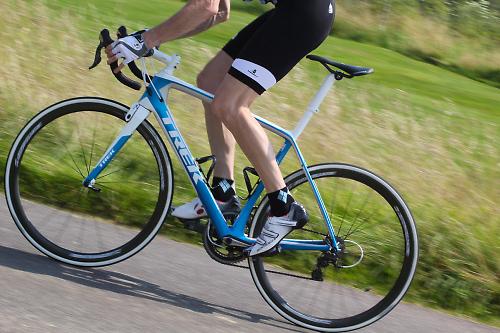
I've had a soft spot for Trek's Madones for a while because the ones I've ridden in the past have been soooo responsive. They're light and punchy, sharp-handling and lots of other things that you want from a performance-driven road bike. The good news is that this new design is the best ever. It's an absolute delight to ride.
What we have here is a bike built around the 2013 Madone 6 Series frame. You'll find the new features described below on the cheaper 5 Series (complete bikes starting at £2,100) and the newly introduced and more expensive 7 Series.
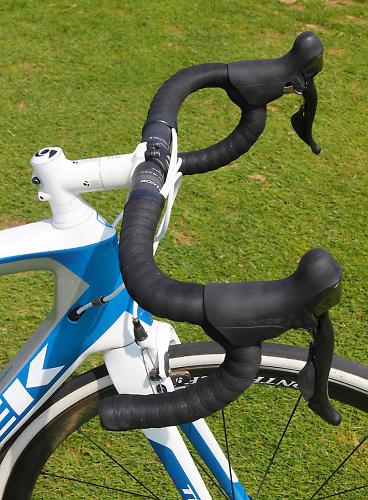
The difference is in the carbon. The 6 Series bikes use 600 Series OCLV (optimum compaction low void, if you're interested) carbon which has a higher stiffness-to-weight ratio than you get with the 5 Series but a lower stiffness-to-weight ratio than the 7 Series.
All three of these Series (but not the lower end Madones) get a completely new frame design for 2013...
New KVF tubing
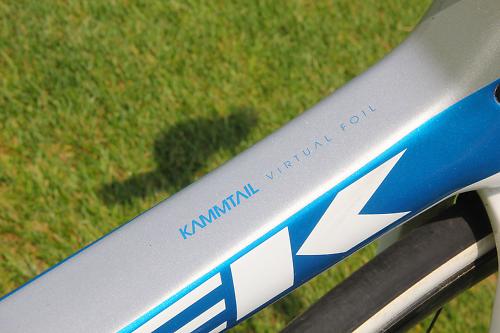
The biggest new feature is the KVF aero tubing. KVF? It stands for Kammtail Virtual Foil and it was first introduced on Trek's Speed Concept time trial bike.
Essentially, the KVF tube profile is an airfoil shape with the tail chopped off square. Trek reckon that the design makes the air behave as if the tail was actually there in order to reduce drag. The advantages of cutting the tail off are that it uses less material and so reduces weight; it works well in crosswinds; and it allows Trek to stay within the UCI's equipment rules.
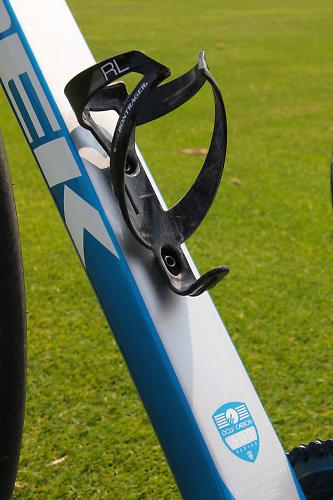
You can see the KVF shape most clearly on the down tube – the sides curve around and then the rear edge is cut off flat. Trek use the same shaping on the head tube, seat tube, the seat stays and the upper portion of the fork blades. Extensively, then.
How much difference does it make? You have to have a statistic these days and Trek say the KVF shaping reduces frame (not including fork) drag by 60g over the previous generation Madone. Without taking the bike to a wind tunnel, we couldn't tell you how accurate that is. We're reporting it rather than confirming it.
Brake design
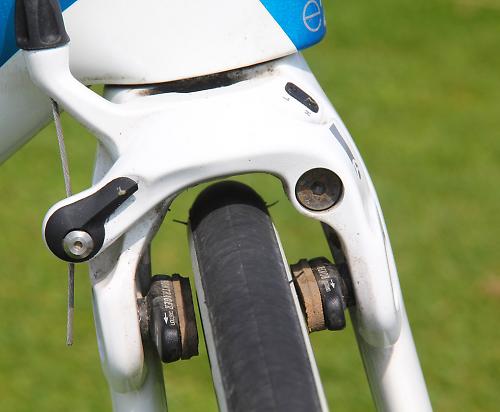
Integration has become ever more important in bike design recently with manufacturers seeking to reduce drag by making everything blend together for more aerodynamic efficiency.
Trek have been busy creating their own new front brake that fits neatly to the fork. Well, their in-house Bontrager brand have. One arm of the Bontrager Speed Limit brake is attached via a central bolt, the other fixes direct to the fork leg. This saves a little weight and allows the two arms to sit flush against the fork crown. Trek reckon that the combined effect of the KVF fork shaping and the integrated front brake reduces drag by another 76g.
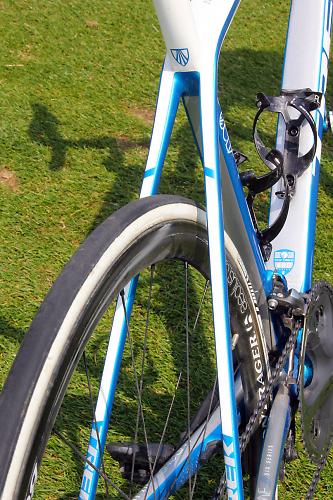
Trek put the rear brake just behind the bottom bracket – a position that has been used on many bikes down the years including a whole bunch of today's time trial machines.
Slinging the brake down here allows Trek to keep it hidden from the wind for improved aerodynamics. It also means there's no longer any need for a brake bridge between the seatstays, cleaning up the airflow in that area. Plus, because they don't have to deal with the braking forces, those seatstays can be made with less material to reduce weight.
It works well. You'd be hard pressed to tell any difference between the braking power you get with Trek's new design and a standard set-up. I wouldn't say there's much in it either way. You can adjust the pad position of the rear brake on the fly just as easily as if it was mounted in the standard position because Trek fit a barrel adjuster at the point where the cable enters the head tube.
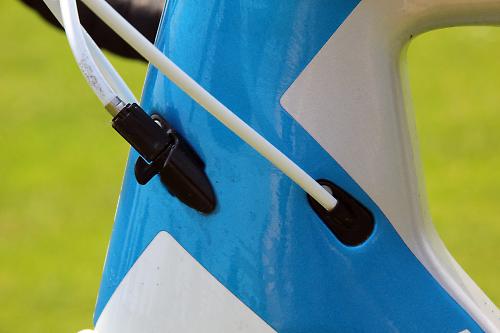
I did wonder whether the positioning of the rear brake would mean it would get bunged up with gunk from the UK's perma-damp roads, but that hasn't been an issue. It is a little more awkward than usual to clean but it's really not much of a problem.
Other features
The new Madone naturally comes with internal cabling, the rear mech cable emerging right at the end of the chainstay, and it's fully compatible with Di2 electronic shifting.

Trek continue their integration theme with a DuoTrap digital sensor recessed into the chainstay. You'll probably already know that this can take speed and cadence measurements and send them wirelessly (ANT+ compatible) to a computer on your bars.

Trek also integrate their 3S chain keeper directly onto the frame. It's a tiny plastic stop that bolts to a threaded hole just above the bottom bracket. There's no great level of technology going on here but it's really unobtrusive and it works to prevent the chain coming off the inner chainring and damaging any of that lovely carbon.
The ride
Okay, so that explains a few of the 2013 Trek Madone's key design features, but how does it ride? That, after all, is what matters.
Well, put simply, this bike rides beautifully. For a start, the lightness and punchiness of previous generation Madones is still there. Our complete bike weighs in at 6.78kg (14.9lb). That's with a mechanical Dura-Ace 7900 groupset and Bontrager's Aeolus 5 clinchers (we're going to do a separate review of those, so standby for that).
You can choose your own spec through Trek's Project One custom programme. Our one would cost you £6,725 – those wheels really jack the price up – although you can have a 6 Series Madone from £3,400 if you adjust the spec.
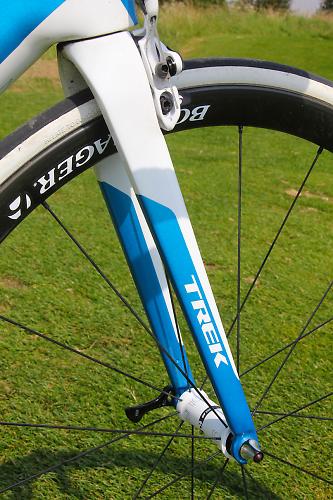
The Madone really flies forward the second you increase the power. It reacts so quickly. And when you get busy on the climbs, it's perfectly happy to pitch in and do its part.
I'm pretty big by cycling standards (75-77kg) and, despite its light weight, the Madone stood up to all the power I could sling its way. Trek's E2 head tube houses a standard 1 1/8in upper bearing with a big 1 1/2in bearing at the bottom, and it's a chunky piece of work. It holds the front end super-stable and, along with those KVF fork blades, it makes for precise handling through long, sweeping turns and quick, zigzagging ones.
The bottom bracket is Trek's BB90 standard with widely spaced bearings and there's very little flex there either. As far as I can tell, Trek have managed to keep all of the Madone's frame stiffness with this latest incarnation. Despite the big changes, it's every bit as solid as before.
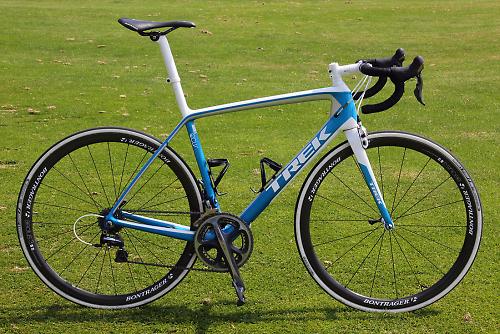
The other big feature is vertical compliance. Now, I don't really like to go on about vertical compliance too much because it's the biggest cliché in cycling. On Road.cc, we tend to take the Mick when manufacturers mention it because they'll wheel out the phrase even if their bike rides like a boneshaker. But that's not to say that vertical compliance isn't a valuable property for a bike to have; it certainly is if you want a comfortable ride.
The reason I bring it up is because the new Madone does have plenty of, you know... VC. Sorry, it just does, especially compared to other aero road bikes I've ridden. That back end in particular just seems to soak up rough roads, unexpected dips and so on.
It helps that I have such a massive (some might say 'ridiculous') amount of seatpost to take the sting out of things. Well, not seatpost exactly... the Madone uses what Trek call 'a no-cut Ride Tuned seat mast'. In other words, you get an extended seat tube with a long mast topper on the outside that gives you 10cm of adjustment. As the name suggests, you don't need to cut the seat tube to length like you do with some systems.
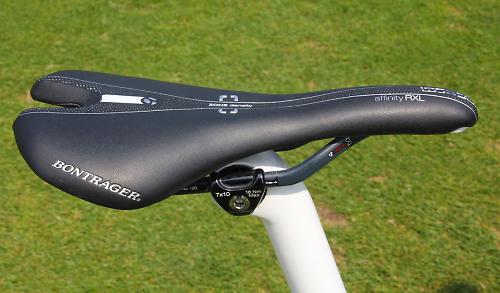
I can't say I'm a huge fan of the Bontrager Inform Affinity RXL saddle. Buy it separately and it's a £100 perch with carbon rails and a carbon-fibre reinforced shell. It's just that I found it to sag in the middle and that's really not comfortable for me. But, when it comes to saddles, one man's meat is another man's poison. Probably not the best choice of words there. Ahem!
As for the ride position, our 6 Series frame is built to Trek's H1 fit which is designed to be low and aero. Trek have increased the reach of the existing H1 geometry a touch for a slightly more stretched ride position.
I'm happy with that setup and find it perfectly comfortable but you might not, in which case, you're in luck... The 6 Series is available in an H2 fit too. The biggest difference is in the length of the head tube. With the H1 fit it's 16cm on a 58cm frame; with the H2 fit it's 19cm. That means your ride position is a little more upright to take the strain off your back and neck, without the need to use a stack of flexing spacers. The H2 setup is still performance-orientated, but it's a bit more relaxed.
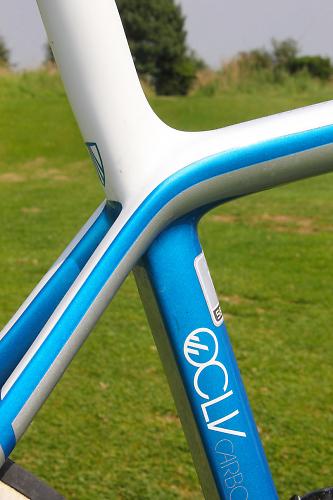
I won't bother telling you about the Shimano Dura-Ace groupset because it's not standard – although, as I said, you can spec it if you go through the Project One system. You can also choose your own colour and have your name on the top tube if that's your thing.
I won't tell you about the Aeolus 3 wheels either because we're going to cover them in a separate review. They're brilliant though.
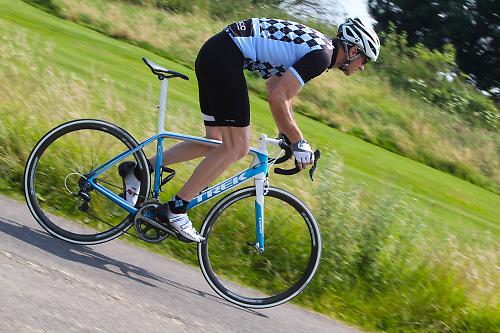
So, that just leaves me to round things up and I'll do that by saying the new Madone is an absolute triumph. It really is. It's light, it's very, very fast and it's way more comfortable than you've a right to expect of a high-performance bike (albeit that I didn't get on too well with the saddle).
I'd love to be more critical and give you a few negatives as well but I'm not going to do that just for the sake of it. This is one of the very best road bikes out there. If the 7 Series is even better, well, we'll happily ride one of those for a bit too. In the meantime, I suppose we'd better box this one up and send it back.
Verdict
Lightweight, very fast and comfortable - a super-high performance bike that won't disappoint, if you have the cash.
road.cc test report
Make and model: Trek Madone 6 Series 2013 (custom build)
Size tested: Project One build
About the bike
State the frame and fork material and method of construction. List the components used to build up the bike.
The frame is made from 600 Series OCLV carbon
The fork is full carbon too, including the dropouts
Our bike came with this spec:
Groupset Shimano Dura-Ace 7900
Brakes Bontrager Speed Limit integrated brakes with Shimano Dura-Ace levers
Wheels Bontrager Aeolus D3 3
Handlebar Bontrager Race XXX Lite VR-C
Stem Bontrager Race X Lite
Saddle Bontrager Affinity RXL Carbon
Tell us what the bike is for, and who it's aimed at. What do the manufacturers say about it? How does that compare to your own feelings about the bike?
It's a race/performance bike. The pros teams might be on 7 Series Madones but, really, the 6 Series of bikes are professional level.
In the build we have, it's 6.78kg without pedals (size 58cm). Add the pedals and it's just above the UCI's 6.8kg minimum weight limit for racing.
Trek say, "Madone 6 Series is race-bike royalty, with its legacy of 9 Tour de France wins. Still the same incredible ride feel and hand-built quality, now with an all-new super-aero shape.
"6 Series has charged the steepest climbs, staged the biggest comebacks, carried the greatest legends. It will take you past your limits, beyond your expectations."
Frame and fork
Overall rating for frame and fork
9/10
Tell us about the build quality and finish of the frame and fork?
Spot on. You can chose your own colour from a vast selection.
Tell us about the materials used in the frame and fork?
The frame is Trek's 600 Series OCLV carbon. For all the details, including how it compares to their other grades of carbon, go to Trek.
Tell us about the geometry of the frame and fork?
You get to choose between Trek's H1 and H2 geometries.
Essentially, H1 is low and aero. H2 is a little more relaxed. The main difference is in the height of the head tube. It's a bit longer with the H2 so you get a more upright ride position - although it's still a performance-orientated set-up.
How was the bike in terms of height and reach? How did it compare to other bikes of the same stated size?
See above on that. You can go for low and stretched or a bit more relaxed.
Riding the bike
Was the bike comfortable to ride? Tell us how you felt about the ride quality.
Very comfortable, yes, especially for a performance-orientated machine.
Did the bike feel stiff in the right places? Did any part of the bike feel too stiff or too flexible?
Yep, it's as rigid around the front end and bottom bracket as previous generation Madones, as far as I can tell.
How did the bike transfer power? Did it feel efficient?
Yeah. Trek have built plenty of Tour-winning bikes in the past and this one is the equal of those in terms of efficiency.
Was there any toe-clip overlap with the front wheel? If so, was it a problem?
A touch on the 58cm frame we have. Not a problem, though.
How would you describe the steering? Was it lively, neutral or unresponsive? The lively side of neutral.
Tell us some more about the handling. How did the bike feel overall? Did it do particular things well or badly?
It feels super-smooth compared to a lot of other high-performance bikes and the steering is pin sharp.
Which components had the most effect (good or bad) on the bike's comfort? would you recommend any changes?
I actually didn't especially like the saddle. I felt the comfort was despite the saddle rather than because of the saddle. It's always a matter of individual taste. There's plenty of give in the frame and seatmast to keep things feeling smooth.
Rate the bike for efficiency of power transfer:
9/10
Rate the bike for acceleration:
9/10
Rate the bike for sprinting:
9/10
Rate the bike for high speed stability:
8/10
Rate the bike for cruising speed stability:
8/10
Rate the bike for low speed stability:
8/10
Rate the bike for flat cornering:
9/10
Rate the bike for cornering on descents:
9/10
Rate the bike for climbing:
9/10
The drivetrain
Rate the drivetrain for performance:
9/10
Rate the drivetrain for durability:
8/10
Rate the drivetrain for weight:
8/10
Rate the drivetrain for value:
7/10
Not especially good value compared to Ultegra or 105 but very good value compared to top-end groupsets from the other leading brands
Wheels and tyres
Rate the wheels and tyres for performance:
9/10
Rate the wheels and tyres for durability:
8/10
Rate the wheels and tyres for weight:
7/10
You can get lighter wheels; these major on aerodynamics.
Rate the wheels and tyres for comfort:
8/10
Rate the wheels and tyres for value:
7/10
Controls
Rate the controls for performance:
9/10
Rate the controls for durability:
8/10
Rate the controls for weight:
9/10
Rate the controls for comfort:
8/10
Your summary
Did you enjoy riding the bike? Yes.
Would you consider buying the bike? Yes.
Would you recommend the bike to a friend? Without doubt.
Rate the bike overall for performance:
9/10
Rate the bike overall for value:
7/10
About the tester
Age: 41 Height: 190cm Weight: 75kg
I usually ride: My best bike is:
I've been riding for: Over 20 years I ride: Most days I would class myself as: Expert
I regularly do the following types of riding: time trialling, commuting, club rides, sportives, general fitness riding,
Mat has been in cycling media since 1996, on titles including BikeRadar, Total Bike, Total Mountain Bike, What Mountain Bike and Mountain Biking UK, and he has been editor of 220 Triathlon and Cycling Plus. Mat has been road.cc technical editor for over a decade, testing bikes, fettling the latest kit, and trying out the most up-to-the-minute clothing. He has won his category in Ironman UK 70.3 and finished on the podium in both marathons he has run. Mat is a Cambridge graduate who did a post-grad in magazine journalism, and he is a winner of the Cycling Media Award for Specialist Online Writer. Now over 50, he's riding road and gravel bikes most days for fun and fitness rather than training for competitions.
Latest Comments
- Oldfatgit 3 sec ago
Thank you for asking Aidan, much appreciated....
- Aluminium can 5 hours 50 min ago
While I always have lights on day and night and wear fluro, I have a friend that wears all black all the time and doesn't use lights ever. His...
- eburtthebike 7 hours 54 min ago
A sad case, and one with no winners. The driver can thank her lucky stars that the cyclist wasn't more seriously injured and that the court was...
- ktache 8 hours 59 min ago
And I liked endura too. Got a nice long sleeve mostly merino long sleeve a little while back, in orange.
- matthewn5 9 hours 27 min ago
No, the Ebay lights have been around for several years, this Lezyne light just appeared.
- chrisonabike 9 hours 43 min ago
They shouldn't worry - the second part of the "tariff" refrain is "they can make it in US and they'll do very well".
- Mr Blackbird 10 hours 15 min ago
"At the going down of the sun, it will get in our eyes and cause us to crash into things."
- Rendel Harris 10 hours 23 min ago
Been living in the area thirty years now and Brixton Cycles (and local riders wearing their famed Rastafarian colours jersey) has been an iconic...
- chrisonabike 15 hours 19 min ago
Indeed - but again these are perhaps questions we should keep asking. Even if the immediate answer is "well we are where we are" or "how on earth...























Add new comment
7 comments
As I am one lucky bastard to own one of these I would like to say that I really enjoy riding it for the 2 months I have had it. The photos in this reveiw show great detail, probaly better than Trek can show in their catalogues. There are stiffer bikes out there according to statistics, but honestly these bikes are really responsive, and attention to detail is great. When I get off my seat on the hills this bike just wants to go. Could you get to do a reveiw of the 6 series Domane with mechanical 11 speed Durace, and compare with this Madone, comparing both frames and 10 and 11 speed Durace. Woody45
Woody45
It's possibly a small detail, but one of things I love about the Trek kit is the DuoTrap compartment. Attention to detail like that matters to me and hints that other things have also had a little more care taken over them. Personally I'd go for a Domane as the roads around where I live are far from ideal...but this is stunning.
I think the translation to grams is effectively a comparative that makes it easier for cyclists to understand. Rather than talk about how it reduces the drag coefficient, they talk in grams because people can understand how this is equivalent to, say buying a lighter group set, or saddle, for instance. So if I am thinking of buying a bike, and like one that weight 6.80Kg, and the other weighs 7.0Kg, but is fandangled in such a way that it reduces drag by 200g, there's no real difference.....I think that is the logic.
But if I was an engineer I would probably dislike the terminology, but I guess most people without an engineering background would struggle to understand how a drag coefficient would affect their ride, especially when so often there are so many factors that add to or detract from riding performance - aerodynamics and weight being just two.
im going to say something i have never said before.. these new treks actually look really impressive.
Have to agree. Never liked Trek much, always seemed a bit sterile and a bit ugly. Nothing offensive, just very anonymous. This model really does look the part.
In science and engineering drag would typically be measured in Newtons, ie. units of force.
I'm not sure why the cycling community measure it in grams, as of course grams (kilograms SI) is a measurement of mass. Weight on the other hand, is a force due to mass sitting in a gravitational field. Measuring drag in grams, is, in my view (as an engineer) just wrong.
To convert grams to a force in Newtons just multiply the mass (in kilograms!) by 9.8 m/s^2 which is the gravitational acceleration at the earth's surface. If we start cycling in space the cycling companies will need to adjust
Why is drag measured in weight (grams) as opposed to er...erm, well whatever you measure drag with?